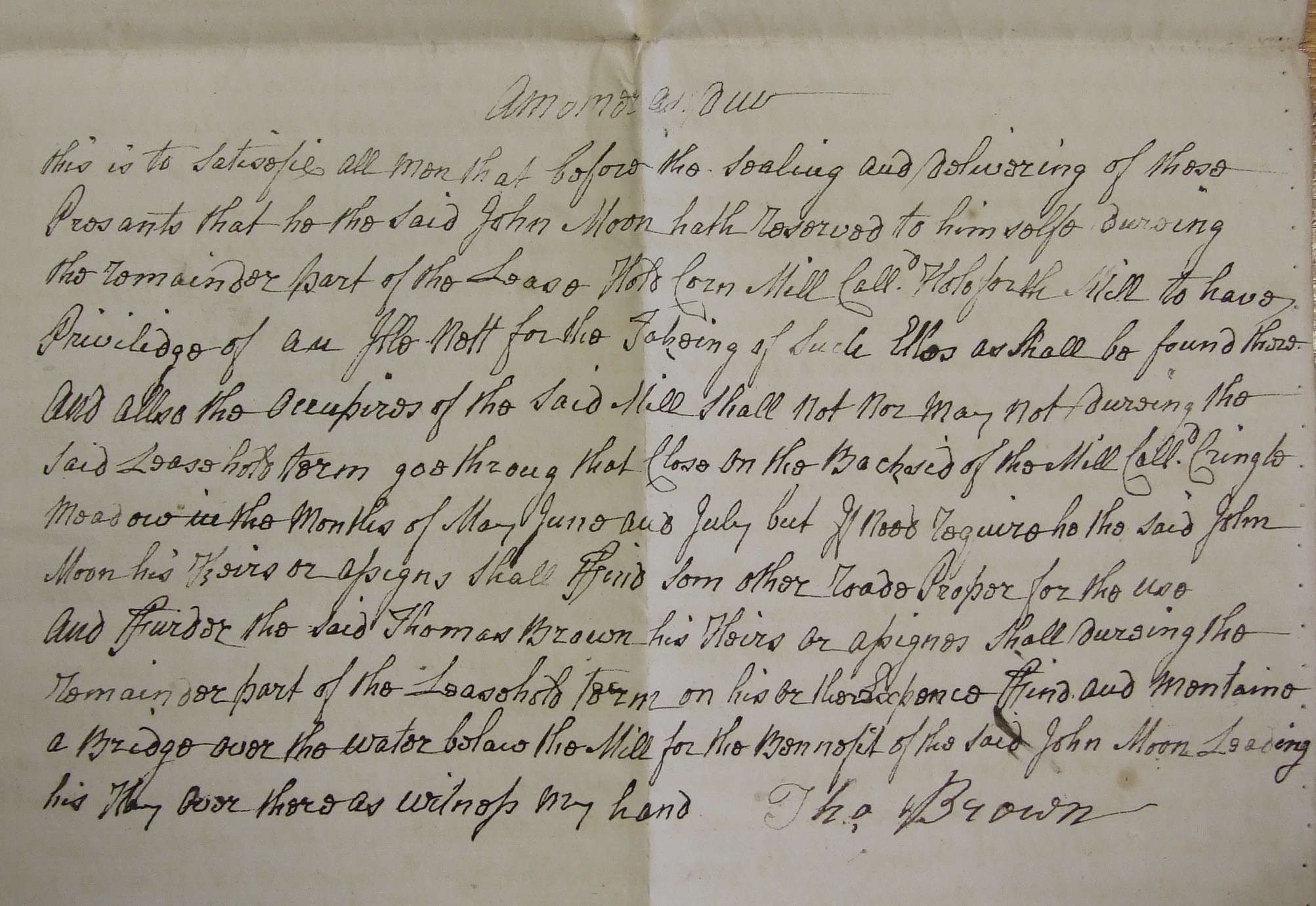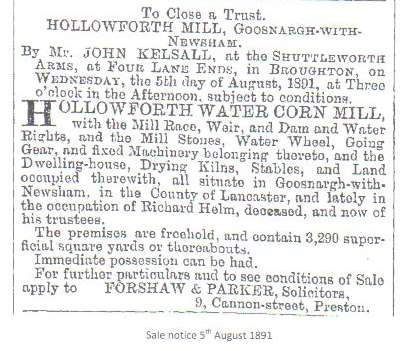History
In this section we are trying to put some form of historical perspective our discoveries.
The mill we are excavating can be traced back definitively to the mid 1790's because of the canalization of the mill race under the canal. Earlier references shown below should be treated as "possibles". Archaeology should provide a more certain answer.
The first record of a mill at Hollowforth* is contained in:-
Concord No: 58
At Lancaster, on the Octave of Holy Trinity, 20 Edward I. [8th June 1292]
Between Robert, son of Adam de Holand, plaintiff, and Adam de Neusam, deforciant of a mill, two oxgangs of land, and ten denariates of rent in Neusam [Newsham*].
Adam de Neusam acknowledged the mill, land and rent to be the right of Robert, as those which he had by the gift of Adam, to hold him and his heirs in perpetuity, of the chief lords of the fee, by the services thereto belonging. For this acknowledgement Robert gave him a sor sparrow-hawk.
The word "sor" refers to the colour of the hawk. Probably a chestnut color.
*Newsham and Hollowforth seem to have been interchangeable in former times.
From "History of the County Palatine and Duchy of Lancaster" by Edward Baines
Page 406
The abbey of Cockersand held two carucates of land in Newsome, or Newsham, on account of which a claim was made by John the abbot, to exemption from suit and service to the county and wapentake.
Dr Kuerden's MS 4to. fo. 57. In the Chetham Libr.
The [above] claim is without date, but the validity of a similar claim was tried in 20 Edward I., and the exemption allowed as to Newsome.
PLacit. de Quo. Warr. 20 Edw. I Lanc. Rot. 7
In 17 Edward II. William de Holland of Eukestone held a messuage, lands and a water-mill in Newsom, in Amundenesse.
Escaet. 17 Edw. II. n. 54. (could be 51?)
From "Goosnargh, past and present" by Richard Cookson.
https://archive.org/stream/goosnarghpastpre00cookiala/goosnarghpastpre00cookiala_djvu.txt
In 1 7th Edward II. (1324), William de Holland, of Eukestone, held a messuage, lands, and a watermill in Newsom, in Amounderness.
The present mill (written in 1887) is thus inscribed :
I.W. JOHN WARREN. E.W. ELIZABETH WARREN. 1702.
s. D.
From Woodplumpton & its families religion houses by George Jackson
1728 William Billington was a dryster at Plumpton Mill
A dryster being the person in charge of drying the grain in a Kiln. Also there was another mill in Woodplumpton - to the South East of the village - so this might not refer to the Hollowforth/Newsham mill.
Lancashire Archives holds a series of indenture starting between George Warren of Stockport on the one part and John Threlfall of Myresccough which mentions a Woodplumpton mill (1757) (later called Hollowforth mill) and ends up with an agreement between John Moon and Thomas Brown in 1795 (see later).
From "THE HAYDOCK PAPERS".
In 1768, during the anti-Jacobite and No-Popery fermentation at Preston, Newhouse chapel narrowly escaped destruction. An infatuated mob, after destroying St. Mary's chapel, in Friargate, Preston, and burning that at Cottam, moved in the direction of Newhouse for the purpose of demolishing the chapel there. But a neighbouring Protestant, named Hankinson, a descendant of the family of the man who betrayed George Haydock, the martyr, met the mob near Hollowforth Mill, and persuaded them not to touch the chapel. He entreated them not to molest Mr. Carter, whom he highly praised. He then provided them with food and drink, which appeased them, and thus they marched back to Preston.
5th June 1795
Agreement between William Threlfall and ........ on behalf of the Lancaster Canal Navigation Company for
"part of a close called Kester Park, the High Field and the Brook Meadow situate in the Hamlet of Newsham in the Township of Goosnargh now in possession of the said William Threlfall as farmer thereof"
"first for the Kester Park at and after the rate of £180 per acre and for the Highfield at and after the rate of £100 per acre and for the Brook Meadow at and after the rate of £195 per acre customary measure and £40 for Severance by reason of no Occupation Bridge and the said proprietors shall take the West side of the Brook Meadow at and after the same rate as that is taken for the said Canal."
LRO code DDX/88/6
This probably refers to land just to the North of Moons mill but it does give a lower date for the building of the canal and therefore the mill race under the canal.

Addition to an indenture 1795. Transcribed this looks like:
A memor…du.?? (A memorandum)
This is to Satisfie all Men that before the Sealing and delivering of these Presants that he the said John Moon hath Reserved to himselfe during the Remainder Part of the Lease Hold Corn Mill calld Hollowforth Mill to have Privilidge of an Ille (eel) Nett for the Takeing of Such Illes (eels) as shall be found there.
And also the Occupires of the Said Mill Shall Not Nor May Not during the said Leasehold term goe throug that Close on the Backsid of the Mill calld Cringle Meadow in the Months of May, June and July but if Need Require he the said John Moon his Heirs or assigns Shall Find som other Roade Proper for the use and furder the said Thomas Brown his Heirs or assignes Shall during the Remainder Part of the Leasehold Term on his or their expense Find and Maintaine a Bridge over the water below the Mill for the Bennefit of the said John Moon Loading his Hay over there as witness my hand Thos Brown.
Lancashire Archives reference DDA/264
The Manor or Lordship of Woodplumpton. Sold by auction 5th October 1812 at the Black Bull in Preston.
Lot 43. Hollowforth CORN MILL, and PREMISES, in the occupation of Thomas Brown, and held by one Life, aged 63, under the yearly Rent of £1.0.0 and containing - - -
[there is no description]There was a Kiln Croft (probably a field) at the Lower House farm in the occupation of Mr Robert Breatche. Similarly another one at a farm called BRANDS, and Moss FIELD, now in the occupation of Mr John Moon.
1845 (newspaper article)
STRANGE FEAT BY A COW. On Thusday week, _____ the servants of Peter Brown Esq., at the "Brands" estate, Woodplumpton, discovered that five of his master's cows were missing from a field eddish, near Hollowforth Mill, After a little search he found four of them in an outbuilding closely adjoining the drying kiln. In a short time the remaining animal was found under the kiln floor, in a place called the "Hell Hole". It would appear that she had get on the kiln floor through an aperture in the wall, which is only 40 inches in depth. and her weight (being a large cow, and fat) had forced a hole through the floor, from which she was precipitated a depth of full six feet, carrying along with her a heap of tiles, ponderous stones, and other materials; yet, strange to say, she was not injured in the least; indeed, there was not a mark or blemish on her body. A hole was immediately made in the wall, and she was released from her "prison house". Had the kiln been in use at the time her situation would have been a most perilous one, the probability being that she would have been suffocated, or rather roasted alive. We understand the damage done to the kiln, which amounted to a considerable sum, has been defrayed by Mr Brown.
Lancashire Archives DDX 391/8
Sale by Auction, Tuesday, 13th December 1859, at the Red Lion, Woodplumpton,
Lot 8
All that well accustomed Water Corn Mill.
Well known as Hollowforth Mill, with the Stones, Water Wheel, Machinery and going Gear connected therewith, together with the Land, Drying Kiln, Stable, etc, adjoining thereto, and now in the occupation of Richard Helm, as Tenant from Year to Year.

From London Gazette Friday, September 30th, 1898
Receiving Orders. John Rigby, Hollowfirth Mill. Broughton, Nr Preston, Lancashire, Corn Miller.
